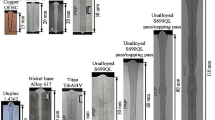Abstract
Laser-induced plasma has been one of the hotspots of high-power CO2 laser welding for many years. A novel method was proposed to suppress the plasma plume through external constraints, which resulted in more stable welding process and slightly increased penetration depth. Based on high-speed camera and image processing technology, it was demonstrated that the expansion of plasma plume both in height and width was suppressed by a pair of water-cooled copper blocks laid near laser incident point along the direction of seam. Besides its intensity and size, the dynamical behavior of plasma plume under spatial constraint was observed and analyzed by the characteristic parameters. The constraint mechanism and influence of the spacing between the two copper blocks was discussed. Results showed that external constraint was effective to suppress plasma plume, stabilize welding process, and to increase weld penetration for high-power CO2 laser welding.
Similar content being viewed by others
References
Kim K, Farsonb D (2001) CO2 laser–plume interaction in materials processing. J Appl Phys 89(1):681–688
Zhang L, Zhang J, Duan A (2006) Numerical and experimental study of the effect of side assisting gas during laser welding, Modelling Simul. Mater Sci Eng 14:875–890
Abdellatifa G, Imamb H (2002) A study of the laser plasma parameters at different laser wavelengths. Spectrochim Acta B 57:1155–1165
Wang C, Meng X, Huang W, Hu X, Duan A (2011) Role of side assisting gas on plasma and energy transmission during CO2 laser welding. J Mater Process Technol 211:668–674
Sabbaghzadeh J, Dadras S, Torkamany MJ (2007) Comparison of pulsed Nd:YAG laser welding qualitative features with plasma plume thermal characteristics. J Phys D Appl Phys 40(4):1047–1051
Peng Y, Chen W, Wang C, Bao G, Tian Z (2001) Controlling the plasma of deep penetration laser welding to increase power efficiency by magnetic fields. J Phys D Appl Phys 34(21):3145–3149
Katayama S, Kobayashi Y, Mizutani M, Matsunawa A (2001) Effect of vacuum on penetration and defects in laser welding. J Laser Appl 13(5):187–192
Hamadou M, Fabbro R, Coste F, Slimani S (2005) Experimental study of CO2 laser welding inside a groove—application to high thickness laser welding. J Laser Appl 17(3):178–182
Li G, Cai Y, Jia S, Steyer D, Billingham J, Wu Y (2010) The influence of different He-Ar ratios on high power CO2 laser welding process and weld formation. Int J Microstruct Mater Prop 5:209–214
Gu H, Duley W (1996) A statistical approach to acoustic monitoring of laser welding. J Phys D Appl Phys 29(3):556–560
Bruncko J, Uherek F, Michalka M (2003) Monitoring of laser welding by optical emission spectroscopy. Laser Phys 13(4):669–673
Chen G, Zhang M, Zhao Z, Zhang Y, Li S (2013) Measurements of laser-induced plasma temperature field in deep penetration laser welding. Opt Laser Technol 45(2):551–557
Bi C, Yang L, Xu W, Wang L (2012) An electrical detection of the fluctuating plasma of laser welding with a passive probe. J Phys D Appl Phys 45:385202
Born M, Wolf E (1999) Principles of optics: electromagnetic theory of propagation, interference and diffraction of light. CUP Archive
Duley W (1999) Laser welding. Wiley, New York, pp 161–190
Liu J, Zhang F, Ma L, Lei D (2004) Study on three-dimension synchrony high-speed photography of plasma during CO2 laser welding. Int Soc Opt Photon 5629:149–154
Fabbro R, Slimani S, Doudet I, Coste F, Briand F (2006) Experimental study of the dynamical coupling between the induced vapour plume and the melt pool for Nd-Yag CW laser welding. J Phys D Appl Phys 39(2):394–400
Matsunawa A, Seto N, Kim J, Mizutani M, Katayama S (2000) Dynamics of keyhole and molten pool in high power CO2 laser welding. Int Soc Opt Photon, SPIE Proc 3888:34–45
Author information
Authors and Affiliations
Corresponding author
Rights and permissions
About this article
Cite this article
Sun, D., Cai, Y., Wu, Y. et al. Effect of external constraint on the characteristics and behavior of the plasma plume during high-power CO2 laser welding. Int J Adv Manuf Technol 73, 1253–1263 (2014). https://doi.org/10.1007/s00170-014-5923-3
Received:
Accepted:
Published:
Issue Date:
DOI: https://doi.org/10.1007/s00170-014-5923-3



